Paul Taylor American Modern Dance at Lincoln Center, March 6 through 25.
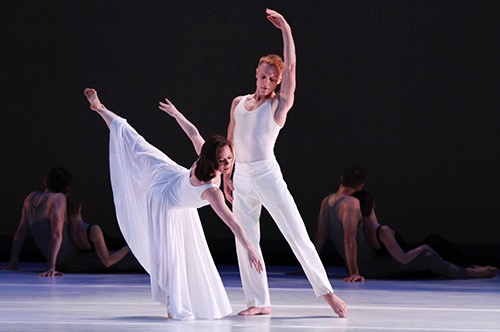
Eran Bugge and Michael Trusnovec in Paul Taylor’s Roses. Photo: Paul B. Goode
When Paul Taylor’s Roses premiered in 1985, fake petals drifted down onto the City Center stage just before the lights went out on his sweet-tempered choreography. No such sprinkling occurred on the second evening of Paul Taylor American Modern Dance’s 2018 three-week season at the former New York State Theater. Would more rose petals have been needed for the bigger stage? Or are they, like everything else these days, too pricey? No, I’m guessing that Taylor may have decided—perhaps years ago— that his lovely, mysterious dance didn’t need the matrimonial slant that audiences eager to decode Roses could claim explained everything.
The music for Roses pairs Richard Wagner’s Siegfried Idyll with Heinrich Baermann’s Adagio for Clarinet and Strings (played by the Orchestra of St. Lukes, conducted by David LaMarche, with Jon Manasse as the soloist). Wagner wrote his chamber music work in honor of his wife’s birthday and the birth of their son, Siegfried. Its musical language really is idyllic—the world as we’d like it to be—and the Adagio by composer-clarinetist Baermann (a generation younger than Wagner) prolongs the dreamlike atmosphere. Two choreographic devices stoke that ambiance further. The five male-female pairs onstage when Roses begins never leave it; when a pair or two dance, the other couples “sleep,” the men most often sitting at ease and the women reclining against them. The stage, beautifully lit by Jennifer Tipton, becomes an enclosed world, even though the dancers, rolling or stepping, to new positions, alter its terrain.
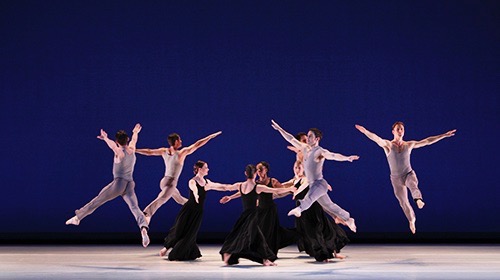
Paul Taylor Dance Company in Taylor’s Roses. Photo: Paul B. Goode
At the outset, the ten form a loose cluster in the center of the stage. The women all wear long, supple, sleeveless black gowns by William Ivey Long; the men are clad in grayish tights and leotards. Within the cluster, pairs pose in differing ways, spool away from it, and return to it. A rose is not a far-fetched image. Several times, they all run in a circle, arms held out, but their hands not touching. Often they link in a distinctive way: each man and woman holds up one hand, and their lower arms press together to create what could be a very formal gesture of joining (or prayer).
This mellow society of Taylor’s isn’t sentimental, and it’s quite diverse. In one duet, Heather McGinley and Sean Mahoney are gentle together, soothing, enabling. In another, Madelyn Ho and Michael Novak also stay close together, but they are constantly—intrepidly—ducking under and diving over each other’s limbs or bodies. The surprise comes when all five pairs have simmered into quiet unison. Another couple enters quietly. Eran Bugge and Michael Trusnovec are dressed in white; the others move to give them space and don’t watch their tender, serene coupling. As they dance, you can see—or think you see—subtle allusions to movements the others have shown us. These aren’t just latecomers to a strange party. What memory, what dream is being evoked? What whole are they a part of? One of many such enigmas have emerged from Taylor’s fertile brain over the years.
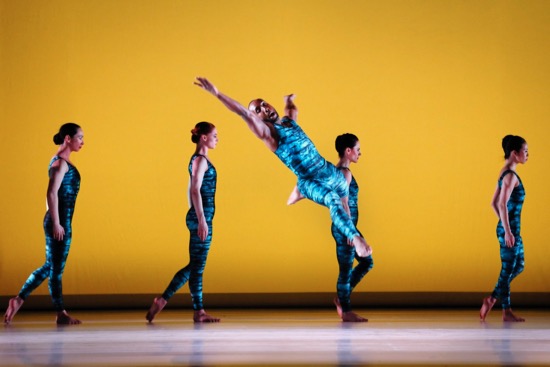
Paul Taylor’s Concertiana. Aloft: Alex Clayton. Passing by (L to R): Christina Lynch Markham, Heather McGinley, Eran Bugge, and Madelyn Ho. Photo: Paul B. Goode
The ten dancers of Roses never leave the stage; the eleven in Taylor’s new Concertiana (his 147th work!) have trouble staying on it. Over the course of the dance, they parade across the back of the area—whether striding, marching, jumping, running, or employing other kinds of locomotion. Later, they travel paths closer to us, crawling on and off, scootching along on their butts, or dragging themselves on their bellies. Ivey Long has costumed them in nearly identical unitards, horizontally banded and mottled in blue and black. James F. Ingalls shifts the lighting on the cyclorama, so we see them against a sky that’s now green, now turquoise, now orange, now lavender.
When the dancers remain on view as an ensemble, they create interweaving lines and other patterns, but almost always, some of them function as a living border, a framing device—but almost always on their way somewhere, busy workers in a phantom factory. They pass through nuggets of temperamental dancing. In one arresting solo, Novak seems to be straining against invisible forces, pulling on them, kicking the air. Later, McGinley dances eagerly, exaltedly, scanning the atmosphere. Four women (Bugge, Ho, McGinley, and Christina Lynch Markham) sit facing us and breathe together before embarking on a dance that keeps them down on the floor and sends them off, seated and oaring along. Taylor uses a favorite device to wrap up this new work of his: The dancers (including James Samson, Mahoney, Michael Apuzzo, George Smallwood, Lee Duveneck, and Alex Clayton) gather centerstage, facing us—nicely posed as if for their high school yearbook. It’s a bit of a shock.
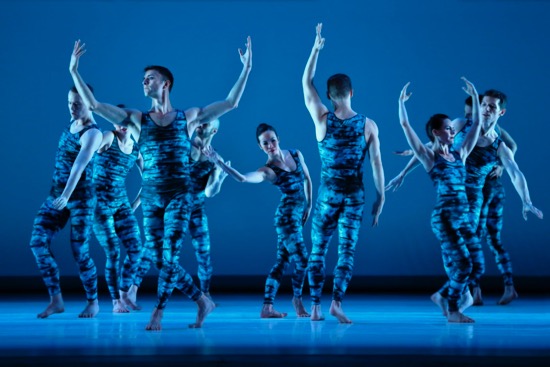
Paul Taylor dancers in his new Concertiana. Photo: Paul B. Goode
Taylor has always created images of community onstage, whether these are dramatic or formal. Sometimes he loves those who people them; sometimes he hates them; sometimes he mocks them. He can mix good and evil in wonderfully imaginative ways. Cloven Kingdom premiered in 1976, and it has never stopped seeming relevant. The program quotes Spinoza: “Man is a social animal.” Keep that “animal” in mind. And, although you can interpret “cloven” simply as a society cleft in two: men here, women there, I enjoy thinking of satyrs with cloven hooves and nymphs frolicking in a glade, even though these nine women wear Scott Barrie’s long, silky gowns in various pale colors, and the four men are outfitted in white tie and tails.
For the first time this evening, we get to see such Taylor stalwarts as Michelle Fleet, Parisa Khobdeh, Laura Halzack, and Robert Kleinendorst besporting themselves along with their colleagues. The music played by the Orchestra of St. Luke’s (Donald York conducting) tells us of the darker, animal urges that occasionally seep through the good manners of a society that prides itself on elegance; Arcangelo Corelli’s baroque harmonies vie with crankier ones by 20th-century American rebel Henry Cowell and Malloy Miller’s percussion. The sweet orderly music doesn’t always accompany sweet orderly dancing, and, from the outset, when Fleet and Jamie Rae Walker separate from the other women and sway their hips gently to Corelli, they also, gracious though they are, lift their bent elbows into wings and hover like vultures, or let their hands briefly dangle like paws.
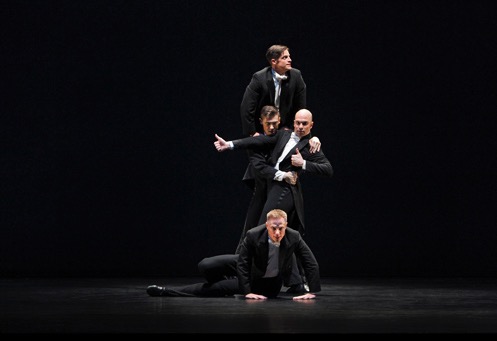
The men of Paul Taylor’s Cloven Kingdom. (Front to back in this cast): MIchael Trusnovev, George Smallwood, Michael Novack, and Michael Apuzzo. Photo: Paul B. Goode
The centerpiece of Cloven Kingdom features the four men (Trusnovec, Kleinendorst, Samson, and Apuzzo) as a tribal unit, stepping precisely to percussion, or sitting in a square to whack imaginary tom-toms while various of them take turns erupting into brief displays of prowess. When they run smoothly, knees bent, bodies leaning slightly back, chins tucked in, wrists limp, you have a hard time separating the dandy from the inner beast.
The women display themselves as predatory in other ways—ambitious maybe. As they leap and dash through, they acquire preposterous headdresses, mirror boxes and balls that, like their big, shiny earrings, reflect the stage lights around the theater. Halzack and Lynch Markham, do things no “lady” would attempt; one disappears under the other’s skirt from behind and crawls forward between her legs to show a puzzled face, as if the silk gown were jungle underbrush. In the end both men and women assume headdresses that cover most of their faces and look, from a distance, to be part fencing masks, part surgical masks—pretentious, protective, and ugly. Some conga line they form!
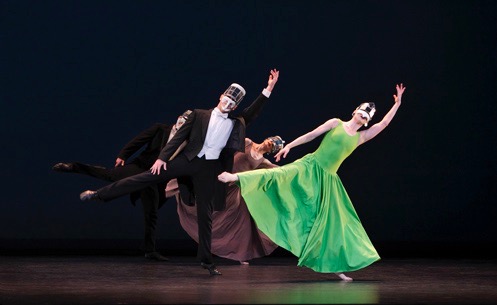
Paul Taylor’s Cloven Kingdom. Foreground: Michael Novack and Heather McGinley. Behind them: Michael Apuzzo and Eran Bugge. Photo: Paul B. Goode
In one part of my mind, I can envision the cast that I saw perform Cloven Kingdom when it premiered, and in some sense, the original performers still live within it. Taylor loves his marvelous dancers—sees them; they influence his choices and, to our delight, bring his visions to fruition. It is a testament to those remarkable visions and the fullness of their recreation by today’s dancers that this piece seems as fresh as it did forty-two years ago.

“In one part of my mind, I can envision the cast that I saw perform Cloven Kingdom when it premiered, and in some sense, the original performers still live within it.”
I think we all do this, to one extent or another, so that people with a long history in the audience see a stage filled with humans — some of them alive and dancing now, and some of them the ghosts of earlier casts.
Loving this review, especially the description of “Cloven Kingdom.”
Ode to Paul
And then there’s
Paul —
last one standing
for whom dance
was a calling
and not a career —
less veneer
and more substance,
blood and guts
like Merce and Martha —
a movement Sidhartha —
seeking to discover
not just movement
but the very soul
of being alive.
FD.3.31.11 And always brought alive in reviews by the inimitable Deborah Jowitt.
I’m honored to receive this from choreographer/dancer/poet Farrell Dyde. And glad that others can enjoy it.